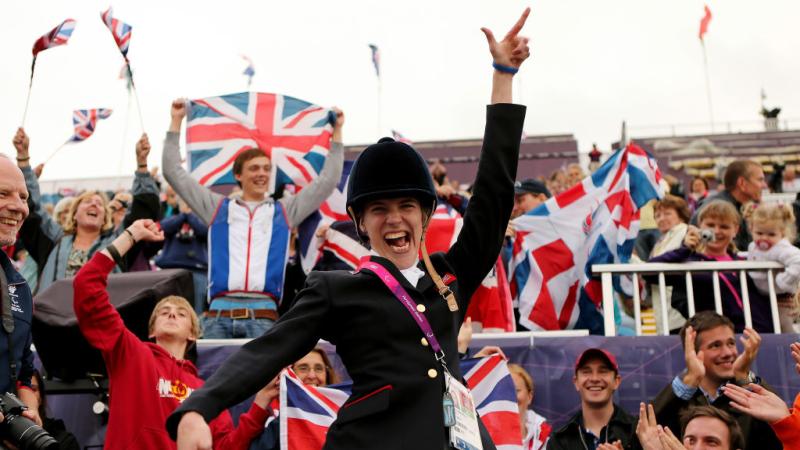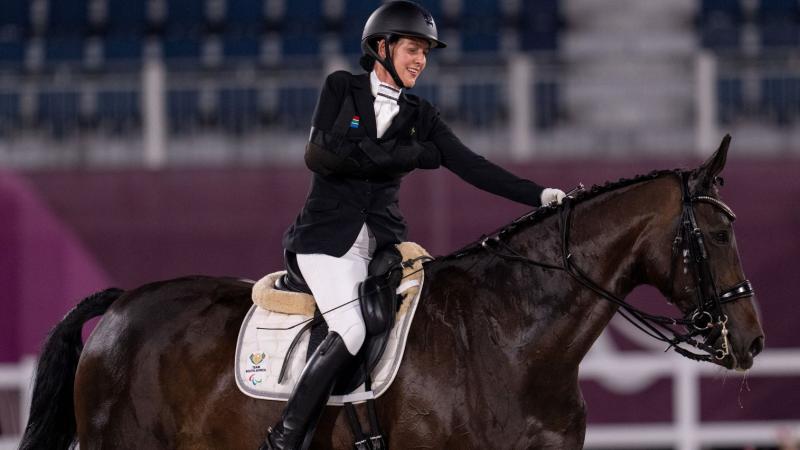
PARA EQUESTRIAN
The only Para sport that includes a live animal, Para equestrian epitomises harmony between riders and horses. It is also the only artistic sport featured in the Paralympic Games sports programme.
about Para equestrian
Para equestrian features the Para dressage discipline. Athletes can compete in dressage events, a championship test of set movements and a freestyle test where they can choose both the routine and their music. A team test event involves three to four members.
Athletes are permitted to use devices such as dressage crops, connecting rein bars, rubber bands and the use of voice to help reinforce communication with their horse.
Para equestrian dressage is conducted under the same basic rules as non-disabled dressage, but with riders divided into different competition grades based on their functional abilities. Para equestrian driving also operates under the same basic rules as combined driving but places competitors in various grades.
The five grades, or classifications, indicate the different impacts of impairment on an athlete’s ability to ride. Competition within the same class includes all genders and it may include athletes with different types of impairments.
Each rider performs a test, and there are three tests in a competition. The team and individual tests see riders carry out a prescribed series of movements, while in the freestyle event riders can choreograph their own routines, incorporating a set number of ‘must have’ movements. Grade I riders perform their tests at walk pace. Grade II riders can walk and trot, while grades III and above can walk, trot and canter (although grade III can canter only in the freestyle).
The competition within each grade is judged on the accuracy, quality, and artistic expression of their riding, regardless of the athlete’s impairment.
The sport is governed by the International Federation for Equestrian Sports (FEI).
Para equestrian History
Para equestrian was originally a means of therapy with participants benefiting from interacting with horses and considered a leisure activity with the first competitions being held in the 1970s.
Para equestrian competition made its debut at the Stoke Mandeville & New York 1984 Paralympic Games and consisted of 12 medal events with competition held in Texas. There were 15 competitors representing six nations.
The sport did not make an appearance in any subsequent Paralympic Games until Atlanta 1996 when Para equestrian became part of the regular sports programme. Today, all events are mixed events with both men and women competing together across five classes.
To date, 19 nations have won medals in Para equestrian competition at Paralympic Games.
DID YOU KNOW?
At 69 years and 65 days, Heidemarie Dresing (GER) was the oldest Para athlete to compete at the Paris 2024 Paralympic Games. She won a bronze medal in the Para dressage freestyle grade II category.

Video
Para EQUESTRIAN News
View more
Best Para equestrian moments of Paris 2024
Belgium's Michele George won her sixth and seventh Paralympic medals with two golds at Paris 2024

Sophie Christiansen announces retirement
Representing Great Britain, Sophie Christiansen has won 10 Paralympic medals across four Games, making her one of the most successful Para equestrian athletes ever.

Para equestrian medallists wrangling toddlers and horses
New mothers Natasha Baker of Great Britain and Denmark’s Katrine Kristensen claim podium finishes at Versailles

Historic venue for Para equestrian at Versailles
Chiara Zenati hopes to medal for France hopes in Paris 'homecoming'

Para equestrian Zenati on finding acceptance and competing at a home Paralympics
France's Para equestrian athlete Chiara Zenati is dreaming big ahead of the Paris 2024 Paralympics.

Introduction to Para equestrian
The sport that epitomises harmony between riders and horses will be contested for the ninth time at the Paris 2024 Paralympics
Federation contact information
TThe Paralympic sport of equestrian is governed by the Federation Equestre Internationale.
CONTACT
Ms. Bettina de Rham
PARALYMPIC AND PARA SPORT RESULTS
Search for all results from Paralympic Games events and selected other international Para sport events.
Equestrian FAQs
Para equestrian dressage is the only equestrian discipline in the Paralympics. Riders prompt their horse to perform a set routine to music of their choice. They are judged on the accuracy and quality of their riding, their horse’s behaviour in gaits and halts, artistic finesse, and other aspects of their performance.
At present Para equestrian does not include any Para showjumping events at the Paralympics.
Competition within each grade is judged on the accuracy, quality, and artistic expression regardless of an athlete’s impairment. Judges look at the movement of the horse only, and not the rider. They judge against set criteria known as scales of training. These cover rhythm, suppleness, contact (between horse and rider), impulsion (the flow of forward movement from the horse’s hind quarters), straightness (the alignment of the horse’s feet) and collection (the balance of the horse and rider).
Judges sit at set points around the arena and score out of 10 for the prescribed movements the horse makes during the test, which normally lasts between four and five minutes.
Athletes who are classified by the International Federation for Equestrian Sports can compete in Para equestrian.



